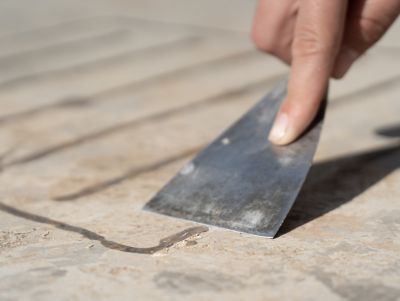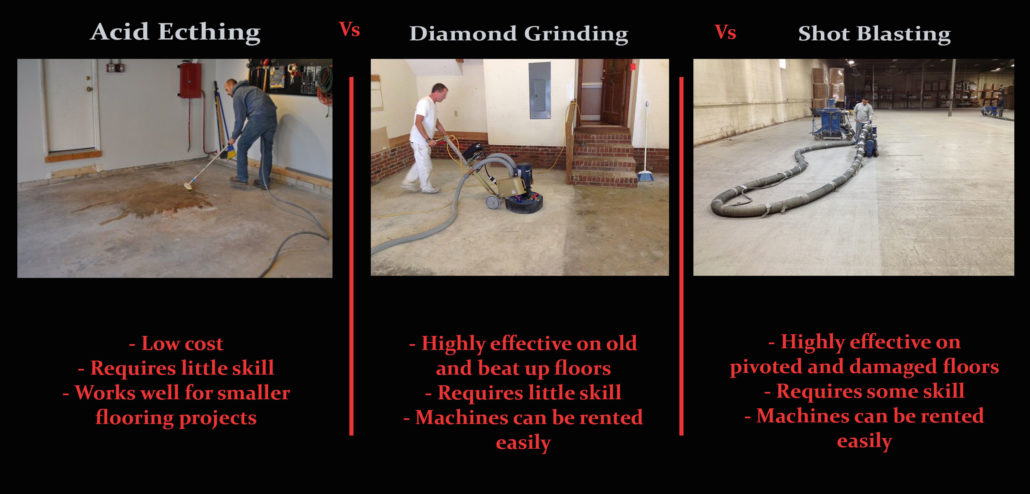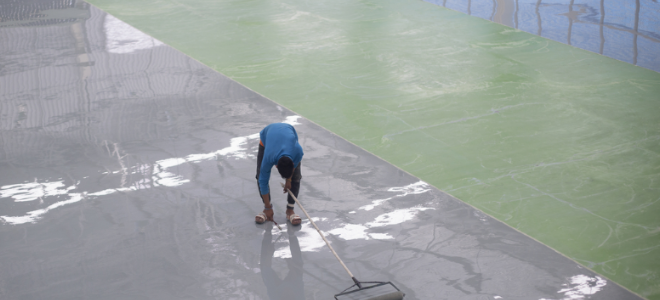Understanding Epoxy Paint and Its Application on Concrete Floors
Epoxy paint is a popular choice for coating and protecting concrete floors. This type of paint is known for its durability, chemical resistance, and ability to create a smooth and glossy finish. Understanding the application process of epoxy paint on concrete floors is essential to ensure a successful and long-lasting result.
To begin with, it is important to prepare the concrete surface properly before applying epoxy paint. This includes cleaning the floor thoroughly to remove any dirt, dust, or grease. It is recommended to use a power washer or a strong detergent solution to get rid of stubborn stains and contaminants.
Once the concrete floor is clean and dry, the next step is to apply a primer. The primer helps to improve adhesion between the concrete and the epoxy paint, ensuring a strong bond. It is crucial to choose a primer that is specifically designed for use with epoxy paint to achieve optimal results.
After the primer has dried, it is time to mix and apply the epoxy paint. It is crucial to follow the manufacturer’s instructions carefully when mixing the paint. Typically, epoxy paint consists of two components – resin and hardener – that need to be mixed together in the correct proportions. Once mixed, the paint should be applied using a roller or a brush, starting from the corners and working towards the center of the floor.
During the application process, it is important to ensure even coverage and avoid leaving any puddles or streaks. It may be necessary to apply multiple coats of epoxy paint to achieve the desired thickness and durability. Each coat should be allowed to dry completely before applying the next one.
Once the epoxy paint has been applied, it is essential to allow it to cure properly. This typically involves leaving the floor untouched for a specific period, as recommended by the manufacturer. During this curing process, the epoxy paint will harden and fully bond with the concrete, creating a strong and durable surface.

Preparing the Concrete Floor for Epoxy Paint Stripping
Stripping epoxy paint from a concrete floor can be a challenging task, but with proper preparation, it can be done effectively. Before beginning the stripping process, it is crucial to prepare the concrete floor to ensure the best possible outcome.
The first step in preparing the concrete floor for epoxy paint stripping is to remove any loose paint or debris. This can be done by using a scraper or a wire brush to gently scrape away the loose particles. It is important to be careful not to damage the concrete surface during this process.
Once the loose paint has been removed, the next step is to clean the floor thoroughly. This can be done by using a detergent solution and a scrub brush or a power washer. It is important to remove any dirt, grease, or other contaminants that may interfere with the stripping process.
After cleaning the floor, it is essential to let it dry completely before proceeding with the epoxy paint stripping. Moisture can affect the effectiveness of the stripping agents, so it is important to ensure that the concrete surface is completely dry.
Next, it is time to choose the appropriate stripping agent for the epoxy paint. There are various types of stripping agents available, including chemical strippers and mechanical methods such as grinding or sanding. It is important to choose a method that is suitable for the specific type of epoxy paint and the condition of the concrete floor.
When using chemical strippers, it is important to follow the manufacturer’s instructions carefully. This includes wearing protective gear such as gloves, goggles, and a respirator to ensure safety during the stripping process. The stripping agent should be applied evenly to the floor, and it may be necessary to let it sit for a certain period to allow it to penetrate and soften the epoxy paint.
Once the stripping agent has had time to work, it can be removed using a scraper or a pressure washer. It is crucial to be cautious and avoid damaging the concrete surface during this process. Depending on the thickness of the epoxy paint and the effectiveness of the stripping agent, it may be necessary to repeat the process multiple times to achieve complete removal.
Effective Methods for Stripping Epoxy Paint from Concrete Floors
Stripping epoxy paint from concrete floors can be a challenging task, but with the right methods, it can be done effectively. There are several effective methods that can be used to remove epoxy paint from concrete floors, each with its own advantages and considerations.
One of the most common methods for stripping epoxy paint from concrete floors is using chemical strippers. Chemical strippers are applied to the floor and left to penetrate and soften the paint, making it easier to remove. It is important to choose a chemical stripper that is specifically designed for epoxy paint removal and to follow the manufacturer’s instructions carefully.
Another effective method for stripping epoxy paint is mechanical removal. This can be done using grinding or sanding equipment. Grinding or sanding machines with diamond blades or abrasive discs can be used to remove the epoxy paint layer by layer, revealing the bare concrete beneath. This method is effective for removing thick layers of epoxy paint but may require professional equipment and expertise.
Heat is another method that can be used to strip epoxy paint from concrete floors. Heat guns or infrared heaters can be used to soften the paint, making it easier to scrape or peel off. It is important to be cautious when using heat, as excessive heat can damage the concrete surface.
In some cases, a combination of methods may be necessary to effectively strip epoxy paint from concrete floors. For example, a chemical stripper can be applied to soften the paint, followed by mechanical removal using grinding or sanding equipment. This combination approach can be particularly effective for removing stubborn or thick layers of epoxy paint.
When using any method for stripping epoxy paint, it is important to take safety precautions. This includes wearing protective gear such as gloves, goggles, and a respirator to protect against chemical fumes or dust. It is also important to ensure proper ventilation in the area where the stripping is taking place.
Safety Measures and Protective Gear for Epoxy Paint Stripping
When it comes to stripping epoxy paint from concrete floors, safety should always be a top priority. The process of removing epoxy paint can involve exposure to chemicals, dust, and other potential hazards. Therefore, it is crucial to take appropriate safety measures and wear protective gear to minimize the risk of accidents or health issues.
One of the most important safety measures when stripping epoxy paint is proper ventilation. Adequate ventilation helps to disperse any fumes or dust that may be generated during the stripping process. It is recommended to open windows and doors and use fans or exhaust systems to ensure a constant flow of fresh air.
Wearing the right protective gear is also essential for personal safety. When working with chemical strippers, it is important to wear gloves to protect the skin from contact with the chemicals. Nitrile or neoprene gloves are typically recommended for this purpose. It is important to choose gloves that are resistant to the specific chemicals being used.
In addition to gloves, goggles or safety glasses should be worn to protect the eyes from any splashes or splatters of chemicals. Epoxy paint stripping can involve the use of strong chemicals that can irritate or damage the eyes, so eye protection is crucial.
A respirator or a mask is another important piece of protective gear when stripping epoxy paint. This helps to filter out any harmful fumes or dust that may be released during the process. It is important to choose a respirator or mask that is specifically designed for the type of chemicals or dust being encountered.
Other safety measures to consider when stripping epoxy paint include wearing long sleeves and pants to protect the skin from contact with chemicals or dust. Closed-toe shoes or boots are also recommended to protect the feet from any spills or accidents.
Additionally, it is important to read and follow the manufacturer’s instructions for any chemicals or equipment being used. This includes proper storage, handling, and disposal of chemicals, as well as understanding any potential hazards or precautions.
Cleaning and Refinishing the Concrete Floor
After successfully stripping epoxy paint from a concrete floor, proper post-stripping care is crucial to ensure a clean and attractive finish. This includes cleaning the floor to remove any residue or debris left behind by the stripping process and refinishing the concrete to restore its appearance and protect it from future damage.
The first step in post-stripping care is to thoroughly clean the concrete floor. This can be done by using a detergent solution a scrub brush or a power washer. It is important to remove any residue or debris, including any remaining traces of the stripping agent, to prepare the floor for refinishing.
Once the floor is clean, it is important to let it dry completely before proceeding with refinishing. Moisture can affect the adhesion and durability of the finish, so it is important to ensure that the concrete surface is completely dry.
The next step is to choose an appropriate sealer or coating for the concrete floor. There are various options available, including epoxy coatings, polyurethane coatings, or acrylic sealants. The choice of sealer or coating will depend on factors such as the desired level of durability, the intended use of the floor, and personal preference.
Before applying the sealer or coating, it is important to ensure that the concrete floor is properly prepared. This includes repairing any cracks or blemishes in the concrete surface and smoothing out any uneven areas. It may be necessary to use a patching compound or a concrete grinder to achieve a smooth and level surface.
Once the floor is prepared, the sealer or coating can be applied according to the manufacturer’s instructions. This may involve using a roller, brush, or sprayer, depending on the type of product being used. It is important to apply the sealer or coating evenly and to follow any specific drying or curing times recommended by the manufacturer.
After the sealer or coating has dried or cured, it is important to maintain the concrete floor properly to ensure its longevity and appearance. This includes regular cleaning to remove dirt, dust, and stains. It is recommended to use a neutral pH cleaner or a mild detergent and avoid harsh chemicals that can damage the sealer or coating.
In high-traffic areas or areas prone to spills or stains, it may be beneficial to apply a sacrificial wax or floor finish. This provides an additional layer of protection and can be easily removed and reapplied as needed.
Regular inspections of the concrete floor should also be conducted to identify any signs of wear or damage. Any cracks or chips should be repaired promptly to prevent further deterioration and to maintain the integrity of the floor.
How To Polish Concrete Floors with Scarab Handheld Grinder
How to Remove Epoxy Flooring
4 Ways to Remove Epoxy Paint – wikiHow
Rust-Oleum 1 gal. Paint Stripper for Concrete 310984
7 Simple Ways to Remove Epoxy from Concrete
How to Remove Old Paint From Concrete Floors : Concrete Floors
Epoxy Floor Removal & Coating Services Shot Blast Inc.
How to Remove Epoxy Coating from Tile Floor One Day Custom
How to Remove Paint From Concrete u2022 Vintage Revivals
Related Posts:












